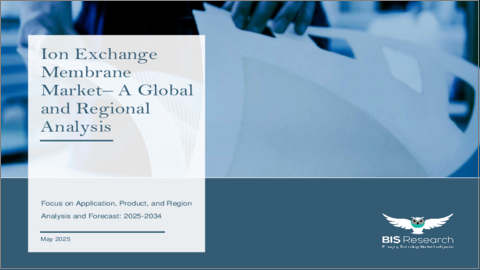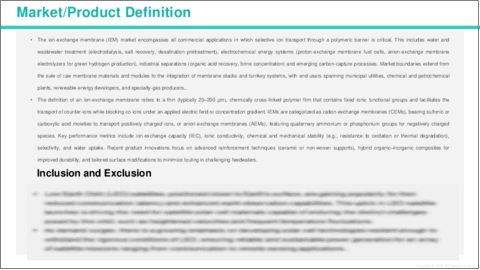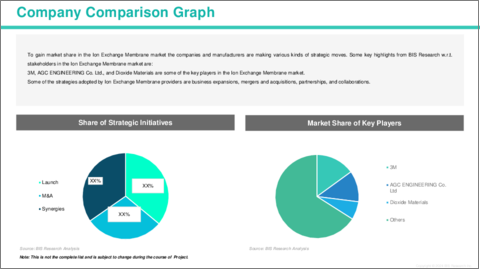|
|
市場調査レポート
商品コード
1722125
イオン交換膜の世界市場:用途・製品・地域別の分析・予測 (2025-2034年)Ion Exchange Membrane Market - A Global and Regional Analysis: Focus on Application, Product, and Region - Analysis and Forecast, 2025-2034 |
||||||
カスタマイズ可能
|
|||||||
| イオン交換膜の世界市場:用途・製品・地域別の分析・予測 (2025-2034年) |
|
出版日: 2025年05月12日
発行: BIS Research
ページ情報: 英文 120 Pages
納期: 1~5営業日
|
全表示
- 概要
- 図表
- 目次
世界のイオン交換膜産業は、互いに連携する三つの階層で構成されています。
まず上流セグメントでは、主要な高分子化学物質 (パーフルオロスルホン酸、炭化水素系骨格) 、補強材料 (セラミックや不織布の支持体) 、特殊添加剤が供給されます。中流セグメントでは、これらの素材が精密なキャスティング、ホットプレス、表面改質といった加工を経て、陽イオン交換膜、陰イオン交換膜、双極膜へと製造されます。下流セグメントでは、水処理、グリーン水素の電気分解、フローバッテリーによる蓄電、特殊分離といった用途向けに、膜スタックを組み立てるシステムインテグレーターやOEMが関与しています。産業全体に浸透している技術革新には、化学的および機械的安定性を高めた有機-無機ハイブリッド複合膜、過酷な原水でも寿命を延ばすための防汚・PFASフリーの表面処理、酸/アルカリをその場で生成可能な双極膜構造、リアルタイムセンサーと連携したデジタルツインプラットフォームによる予知保全と性能最適化などが含まれます。
イオン交換膜市場のライフサイクルステージ
| 主要市場統計 | |
|---|---|
| 予測期間 | 2025-2034年 |
| 2025年評価 | 13億4,000万米ドル |
| 2034年予測 | 22億3,000万米ドル |
| CAGR | 5.82% |
イオン交換膜市場は現在、堅調に成長段階に入り、急速な技術革新と、初期採用者のニッチ用途から産業用・自治体向け用途への採用拡大が特徴となっています。上流の材料サプライヤーが高分子化学を改良し、中流の製造業者が生産体制を拡大する中で、下流のシステムインテグレーターは、グリーン水素用電解装置からゼロリキッドディスチャージ (ZLD) 型廃水処理プラントに至るまで、多様なプロセスにIEMモジュールを組み込んでおり、その性能が実証されることで顧客の信頼も高まっています。この段階では、専門企業の活発な新規参入、戦略的提携、ターゲットを絞った生産能力の拡大が見られますが、成熟市場に典型的な企業統合や利益率の安定化はまだ起きていません。膜仕様の段階的な標準化や、Membrane-as-a-Serviceといった柔軟なビジネスモデルの登場が見られることから、今後5~7年以内に、IEM市場はより成熟し、効率重視のフェーズへと移行すると予測されます。
当レポートでは、世界のイオン交換膜の市場を調査し、主要動向、市場影響因子の分析、法規制環境、技術・特許の動向、ケーススタディ、市場規模の推移・予測、各種区分・地域/主要国別の詳細分析、競合情勢、主要企業のプロファイルなどをまとめています。
目次
エグゼクティブサマリー
第1章 市場:業界展望
- 動向:現状と将来への影響評価
- ステークホルダー分析
- 使用事例
- エンドユーザーと購入基準
- 市場力学の概要
- 市場促進要因
- 市場抑制要因
- 市場機会
- 規制および政策影響分析
- 特許分析
- スタートアップの情勢
- 総潜在市場
- 投資情勢と研究開発動向
- 将来の展望と市場ロードマップ
- バリューチェーン分析
- 世界の価格分析
- 業界の魅力
第2章 イオン交換膜市場:用途別
- 用途のセグメンテーション
- 用途のサマリー
- イオン交換膜市場 (用途別)
- 水処理
- 電気透析
- 電解
- 蓄電池
- その他
第3章 イオン交換膜市場:製品別
- 製品セグメンテーション
- 製品サマリー
- イオン交換膜市場 (材料移動別)
- 無機膜
- 炭化水素膜
- 複合膜
- 部分ハロゲン化膜
- パーフルオロカーボン膜
第4章 イオン交換膜市場:地域別
- イオン交換膜市場 (地域別)
- 北米
- 地域概要
- 市場成長の原動力
- 市場課題
- 主要企業
- 用途
- 製品
- 北米 (国別)
- 欧州
- 地域概要
- 市場成長の原動力
- 市場課題
- 主要企業
- 用途
- 製品
- 欧州 (国別)
- アジア太平洋
- 地域概要
- 市場成長の原動力
- 市場課題
- 主要企業
- 用途
- 製品
- アジア太平洋 (国別)
- その他の地域
- 地域概要
- 市場成長の原動力
- 市場課題
- 主要企業
- 用途
- 製品
- その他の地域 (地域別)
第5章 市場:競合ベンチマーキングと企業プロファイル
- 次のフロンティア
- 地理的評価
- 企業プロファイル
- 3M
- AGC ENGINEERING Co. Ltd
- Dioxide Materials
- DuPont de Nemours, Inc.
- Evergreen Technologies Pvt Ltd
- Fujifilm Manufacturing Europe BV
- SUEZ
- Hyflux Ltd.
- ION EXCHANGE
- LANXESS
- Liaoning Yichen Membrane Technology Co. Ltd
- Merck KGaA
- その他の主要企業
第6章 調査手法
List of Figures
- Figure 1: Ion Exchange Membrane Market (by Scenario), $Million, 2025, 2028, and 2034
- Figure 2: Ion Exchange Membrane Market (by Region), $Million, 2024, 2027, and 2034
- Figure 3: Ion Exchange Membrane Market (by Application), $Million, 2024, 2027, and 2034
- Figure 4: Ion Exchange Membrane Market (by Product), $Million, 2024, 2027, and 2034
- Figure 5: Competitive Landscape Snapshot
- Figure 6: Supply Chain Analysis
- Figure 7: Value Chain Analysis
- Figure 8: Patent Analysis (by Country), January 2021-April 2025
- Figure 9: Patent Analysis (by Company), January 2021-April 2025
- Figure 10: Impact Analysis of Market Navigating Factors, 2024-2034
- Figure 11: U.S. Ion Exchange Membrane Market, $Million, 2024-2034
- Figure 12: Canada Ion Exchange Membrane Market, $Million, 2024-2034
- Figure 13: Mexico Ion Exchange Membrane Market, $Million, 2024-2034
- Figure 14: Germany Ion Exchange Membrane Market, $Million, 2024-2034
- Figure 15: France Ion Exchange Membrane Market, $Million, 2024-2034
- Figure 16: Italy Ion Exchange Membrane Market, $Million, 2024-2034
- Figure 17: Spain Ion Exchange Membrane Market, $Million, 2024-2034
- Figure 18: U.K. Ion Exchange Membrane Market, $Million, 2024-2034
- Figure 19: Rest-of-Europe Ion Exchange Membrane Market, $Million, 2024-2034
- Figure 20: China Ion Exchange Membrane Market, $Million, 2024-2034
- Figure 21: Japan Ion Exchange Membrane Market, $Million, 2024-2034
- Figure 22: India Ion Exchange Membrane Market, $Million, 2024-2034
- Figure 23: South Korea Ion Exchange Membrane Market, $Million, 2024-2034
- Figure 24: Rest-of-Asia-Pacific Ion Exchange Membrane Market, $Million, 2024-2034
- Figure 25: South America Ion Exchange Membrane Market, $Million, 2024-2034
- Figure 26: Middle East and Africa Ion Exchange Membrane Market, $Million, 2024-2034
- Figure 27: Strategic Initiatives (by Company), 2021-2025
- Figure 28: Share of Strategic Initiatives, 2021-2025
- Figure 29: Data Triangulation
- Figure 30: Top-Down and Bottom-Up Approach
- Figure 31: Assumptions and Limitations
List of Tables
- Table 1: Market Snapshot
- Table 2: Opportunities across Region
- Table 3: Trends Overview
- Table 4: Ion Exchange Membrane Market Pricing Forecast, 2024-2034
- Table 5: Application Summary (by Application)
- Table 6: Product Summary (by Product)
- Table 7: Ion Exchange Membrane Market (by Region), $Million, 2024-2034
- Table 8: North America Ion Exchange Membrane Market (by Application), $Million, 2024-2034
- Table 9: North America Ion Exchange Membrane Market (by Product), $Million, 2024-2034
- Table 10: U.S. Ion Exchange Membrane Market (by Application), $Million, 2024-2034
- Table 11: U.S. Ion Exchange Membrane Market (by Product), $Million, 2024-2034
- Table 12: Canada Ion Exchange Membrane Market (by Application), $Million, 2024-2034
- Table 13: Canada Ion Exchange Membrane Market (by Product), $Million, 2024-2034
- Table 14: Mexico Ion Exchange Membrane Market (by Application), $Million, 2024-2034
- Table 15: Mexico Ion Exchange Membrane Market (by Product), $Million, 2024-2034
- Table 16: Europe Ion Exchange Membrane Market (by Application), $Million, 2024-2034
- Table 17: Europe Ion Exchange Membrane Market (by Product), $Million, 2024-2034
- Table 18: Germany Ion Exchange Membrane Market (by Application), $Million, 2024-2034
- Table 19: Germany Ion Exchange Membrane Market (by Product), $Million, 2024-2034
- Table 20: France Ion Exchange Membrane Market (by Application), $Million, 2024-2034
- Table 21: France Ion Exchange Membrane Market (by Product), $Million, 2024-2034
- Table 22: Italy Ion Exchange Membrane Market (by Application), $Million, 2024-2034
- Table 23: Italy Ion Exchange Membrane Market (by Product), $Million, 2024-2034
- Table 24: Spain Ion Exchange Membrane Market (by Application), $Million, 2024-2034
- Table 25: Spain Ion Exchange Membrane Market (by Product), $Million, 2024-2034
- Table 26: U.K. Ion Exchange Membrane Market (by Application), $Million, 2024-2034
- Table 27: U.K. Ion Exchange Membrane Market (by Product), $Million, 2024-2034
- Table 28: Rest-of-Europe Ion Exchange Membrane Market (by Application), $Million, 2024-2034
- Table 29: Rest-of-Europe Ion Exchange Membrane Market (by Product), $Million, 2024-2034
- Table 30: Asia-Pacific Ion Exchange Membrane Market (by Application), $Million, 2024-2034
- Table 31: Asia-Pacific Ion Exchange Membrane Market (by Product), $Million, 2024-2034
- Table 32: China Ion Exchange Membrane Market (by Application), $Million, 2024-2034
- Table 33: China Ion Exchange Membrane Market (by Product), $Million, 2024-2034
- Table 34: Japan Ion Exchange Membrane Market (by Application), $Million, 2024-2034
- Table 35: Japan Ion Exchange Membrane Market (by Product), $Million, 2024-2034
- Table 36: India Ion Exchange Membrane Market (by Application), $Million, 2024-2034
- Table 37: India Ion Exchange Membrane Market (by Product), $Million, 2024-2034
- Table 38: South Korea Ion Exchange Membrane Market (by Application), $Million, 2024-2034
- Table 39: South Korea Ion Exchange Membrane Market (by Product), $Million, 2024-2034
- Table 40: Rest-of-Asia-Pacific Ion Exchange Membrane Market (by Application), $Million, 2024-2034
- Table 41: Rest-of-Asia-Pacific Ion Exchange Membrane Market (by Product), $Million, 2024-2034
- Table 42: Rest-of-the-World Ion Exchange Membrane Market (by Application), $Million, 2024-2034
- Table 43: Rest-of-the-World Ion Exchange Membrane Market (by Product), $Million, 2024-2034
- Table 44: South America Ion Exchange Membrane Market (by Application), $Million, 2024-2034
- Table 45: South America Ion Exchange Membrane Market (by Product), $Million, 2024-2034
- Table 46: Middle East and Africa Ion Exchange Membrane Market (by Application), $Million, 2024-2034
- Table 47: Middle East and Africa Ion Exchange Membrane Market (by Product), $Million, 2024-2034
- Table 48: Market Share
Global Ion Exchange Membrane Market: Industry Overview
The global ion-exchange membrane industry is structured across three interlinked tiers: an upstream segment supplying core polymer chemistries (perfluorinated sulfonic acids, hydrocarbon backbones), reinforcement materials (ceramic and non-woven supports), and specialty additives; a midstream segment where these inputs are processed through precision casting, hot-pressing, and surface-modification techniques to produce cation-, anion-, and bipolar membranes; and a downstream segment encompassing system integrators and OEMs that assemble membrane stacks for applications in water treatment, green-hydrogen electrolysis, flow-battery storage, and specialty separations.Technological innovations permeating the industry include hybrid organic-inorganic composite membranes for enhanced chemical and mechanical stability, anti-fouling and PFAS-free surface treatments to extend lifetimes in challenging feedwaters, bipolar membrane architectures for in situ acid/base generation, and digital-twin platforms coupled with real-time sensor arrays for predictive maintenance and performance optimization.
Ion Exchange Membrane Market Lifecycle Stage
| KEY MARKET STATISTICS | |
|---|---|
| Forecast Period | 2025 - 2034 |
| 2025 Evaluation | $1.34 Billion |
| 2034 Forecast | $2.23 Billion |
| CAGR | 5.82% |
The ion-exchange membrane market is firmly in its growth stage, characterized by rapid technology innovation and expanding adoption beyond early-adopter niches into broader industrial and municipal applications. As upstream materials suppliers refine polymer chemistries and midstream manufacturers scale production, downstream system integrators are integrating IEM modules into diverse processes-from green-hydrogen electrolyzers to zero-liquid-discharge wastewater plants-thereby validating performance and driving customer confidence. This phase is marked by vigorous entry of specialized firms, strategic partnerships, and targeted capacity expansions, but has yet to witness the consolidation and margin stabilization typical of a mature market. Progressive standardization of membrane specifications and the emergence of flexible "membrane-as-a-service" models suggest that the IEM market will transition into a more mature, efficiency-focused phase over the next five to seven years.
Ion Exchange Membrane Market Segmentation:
Segmentation 1: by Application
- Water Treatment
- Electrodialysis
- Electrolysis
- Storage Batteries
- Others
Water Treatment is one of the prominent application segments in the global ion exchange membrane market.
Segmentation 2: by Material Movement
- Inorganic Membrane
- Hydrocarbon Membrane
- Composite Membrane
- Partially Halogenated Membrane
- Perfluorocarbon Membrane
The global ion exchange membrane market is estimated to be led by the perfluorocarbon membrane segment in terms of material movement.
Segmentation 3: by Region
- North America - U.S., Canada, and Mexico
- Europe - Germany, France, Italy, Spain, U.K., and Rest-of-Europe
- Asia-Pacific - China, Japan, South Korea, India, and Rest-of-Asia-Pacific
- Rest-of-the-World - South America and Middle East and Africa
In the ion exchange membrane market, Asia-Pacific is anticipated to gain traction in terms of production, with increasing infrastructure demand and govement initiatives.
Demand - Drivers and Limitations
The following are the demand drivers for the global ion exchange membrane market:
- Green-Hydrogen Expansion via Advanced AEMs
- Growing Emphasis on Environmental Protection
The global ion exchange membrane market is expected to face some limitations as well due to the following challenges:
- High Associated Costs
- Technological Restrictions
Ion Exchange Membrane Market Key Players and Competition Synopsis
The ion-exchange membrane market is dominated by a mix of legacy chemical conglomerates and agile specialty firms that compete on performance, cost, and application focus. DuPont's Neosepta membranes and Asahi Kasei's Selemion series vie for leadership in water treatment, each touting proprietary anti-fouling surface treatments and enhanced chemical stability. In the green-hydrogen space, Evonik's DURAION AEMs and Fumatech's Fumasep(R) F-24 bipolar membranes are locked in a race to supply gigawatt-scale electrolyzer projects, with DuPont recently partnering with Siemens Energy on a 1 GW PEM electrolyzer stack. Toray Industries and Lanxess leverage their scale to offer cost-effective, high-throughput desalination modules, while mid-tier innovators like IonPure target niche zero-liquid-discharge and specialty-chemical recycling applications through modular, skid-mounted systems. Strategic R&D alliances such as Asahi Kasei's 2024 collaboration with the National Renewable Energy Laboratory-and OEM tie-ups underscore an intensely competitive environment where rapid material innovation and localized production are key differentiators.
Some of the prominent established names in this market are:
- 3M
- AGC ENGINEERING Co. Ltd
- Dioxide Materials
- DuPont de Nemours, Inc.
- Evergreen Technologies Pvt Ltd
- Fujifilm Manufacturing Europe BV
- SUEZ
- Hyflux Ltd.
- ION EXCHANGE
- LANXESS
- Liaoning Yichen Membrane Technology Co. Ltd
- Merck KGaA
Companies that are not a part of the previously mentioned pool have been well represented across different sections of the report (wherever applicable).
Table of Contents
Executive Summary
Scope and Definition
Market/Product Definition
Key Questions Answered
Analysis and Forecast Note
1. Markets: Industry Outlook
- 1.1 Trends: Current and Future Impact Assessment
- 1.2 Stakeholder Analysis
- 1.2.1 Use Case
- 1.2.2 End User and Buying Criteria
- 1.3 Market Dynamics Overview
- 1.3.1 Market Drivers
- 1.3.2 Market Restraints
- 1.3.3 Market Opportunities
- 1.4 Regulatory & Policy Impact Analysis
- 1.5 Patent Analysis
- 1.6 Start-Up Landscape
- 1.7 Total Addressable Market
- 1.8 Investment Landscape and R&D Trends
- 1.9 Future Outlook and Market Roadmap
- 1.10 Value Chain Analysis
- 1.11 Global Pricing Analysis
- 1.12 Industry Attractiveness
2. Ion Exchange Membrane Market (by Application)
- 2.1 Application Segmentation
- 2.2 Application Summary
- 2.3 Ion Exchange Membrane Market (by Application)
- 2.3.1 Water Treatment
- 2.3.2 Electrodialysis
- 2.3.3 Electrolysis
- 2.3.4 Storage Batteries
- 2.3.5 Others
3. Ion Exchange Membrane Market (by Product)
- 3.1 Product Segmentation
- 3.2 Product Summary
- 3.3 Ion Exchange Membrane Market (by Material Movement)
- 3.3.1 Inorganic Membrane
- 3.3.2 Hydrocarbon Membrane
- 3.3.3 Composite Membrane
- 3.3.4 Partially Halogenated Membrane
- 3.3.5 Perfluorocarbon Membrane
4. Ion Exchange Membrane Market (by Region)
- 4.1 Ion Exchange Membrane Market (by Region)
- 4.2 North America
- 4.2.1 Regional Overview
- 4.2.2 Driving Factors for Market Growth
- 4.2.3 Factors Challenging the Market
- 4.2.4 Key Companies
- 4.2.5 Application
- 4.2.6 Product
- 4.2.7 North America (by Country)
- 4.2.7.1 U.S.
- 4.2.7.1.1 Market by Application
- 4.2.7.1.2 Market by Product
- 4.2.7.2 Canada
- 4.2.7.2.1 Market by Application
- 4.2.7.2.2 Market by Product
- 4.2.7.3 Mexico
- 4.2.7.3.1 Market by Application
- 4.2.7.3.2 Market by Product
- 4.2.7.1 U.S.
- 4.3 Europe
- 4.3.1 Regional Overview
- 4.3.2 Driving Factors for Market Growth
- 4.3.3 Factors Challenging the Market
- 4.3.4 Key Companies
- 4.3.5 Application
- 4.3.6 Product
- 4.3.7 Europe (by Country)
- 4.3.7.1 Germany
- 4.3.7.1.1 Market by Application
- 4.3.7.1.2 Market by Product
- 4.3.7.2 France
- 4.3.7.2.1 Market by Application
- 4.3.7.2.2 Market by Product
- 4.3.7.3 Italy
- 4.3.7.3.1 Market by Application
- 4.3.7.3.2 Market by Product
- 4.3.7.4 Spain
- 4.3.7.4.1 Market by Application
- 4.3.7.4.2 Market by Product
- 4.3.7.5 U.K.
- 4.3.7.5.1 Market by Application
- 4.3.7.5.2 Market by Product
- 4.3.7.6 Rest-of-Europe
- 4.3.7.6.1 Market by Application
- 4.3.7.6.2 Market by Product
- 4.3.7.1 Germany
- 4.4 Asia-Pacific
- 4.4.1 Regional Overview
- 4.4.2 Driving Factors for Market Growth
- 4.4.3 Factors Challenging the Market
- 4.4.4 Key Companies
- 4.4.5 Application
- 4.4.6 Product
- 4.4.7 Asia-Pacific (by Country)
- 4.4.7.1 China
- 4.4.7.1.1 Market by Application
- 4.4.7.1.2 Market by Product
- 4.4.7.2 Japan
- 4.4.7.2.1 Market by Application
- 4.4.7.2.2 Market by Product
- 4.4.7.3 India
- 4.4.7.3.1 Market by Application
- 4.4.7.3.2 Market by Product
- 4.4.7.4 South Korea
- 4.4.7.4.1 Market by Application
- 4.4.7.4.2 Market by Product
- 4.4.7.5 Rest-of-Asia-Pacific
- 4.4.7.5.1 Market by Application
- 4.4.7.5.2 Market by Product
- 4.4.7.1 China
- 4.5 Rest-of-the-World
- 4.5.1 Regional Overview
- 4.5.2 Driving Factors for Market Growth
- 4.5.3 Factors Challenging the Market
- 4.5.4 Key Companies
- 4.5.5 Application
- 4.5.6 Product
- 4.5.7 Rest-of-the-World (by Region)
- 4.5.7.1 South America
- 4.5.7.1.1 Market by Application
- 4.5.7.1.2 Market by Product
- 4.5.7.2 Middle East and Africa
- 4.5.7.2.1 Market by Application
- 4.5.7.2.2 Market by Product
- 4.5.7.1 South America
5. Markets - Competitive Benchmarking & Company Profiles
- 5.1 Next Frontiers
- 5.2 Geographic Assessment
- 5.3 Company Profiles
- 5.3.1 3M
- 5.3.1.1 Overview
- 5.3.1.2 Top Products/Product Portfolio
- 5.3.1.3 Top Competitors
- 5.3.1.4 Target Customers
- 5.3.1.5 Key Personnel
- 5.3.1.6 Analyst View
- 5.3.1.7 Market Share
- 5.3.2 AGC ENGINEERING Co. Ltd
- 5.3.2.1 Overview
- 5.3.2.2 Top Products/Product Portfolio
- 5.3.2.3 Top Competitors
- 5.3.2.4 Target Customers
- 5.3.2.5 Key Personnel
- 5.3.2.6 Analyst View
- 5.3.2.7 Market Share
- 5.3.3 Dioxide Materials
- 5.3.3.1 Overview
- 5.3.3.2 Top Products/Product Portfolio
- 5.3.3.3 Top Competitors
- 5.3.3.4 Target Customers
- 5.3.3.5 Key Personnel
- 5.3.3.6 Analyst View
- 5.3.3.7 Market Share
- 5.3.4 DuPont de Nemours, Inc.
- 5.3.4.1 Overview
- 5.3.4.2 Top Products/Product Portfolio
- 5.3.4.3 Top Competitors
- 5.3.4.4 Target Customers
- 5.3.4.5 Key Personnel
- 5.3.4.6 Analyst View
- 5.3.4.7 Market Share
- 5.3.5 Evergreen Technologies Pvt Ltd
- 5.3.5.1 Overview
- 5.3.5.2 Top Products/Product Portfolio
- 5.3.5.3 Top Competitors
- 5.3.5.4 Target Customers
- 5.3.5.5 Key Personnel
- 5.3.5.6 Analyst View
- 5.3.5.7 Market Share
- 5.3.6 Fujifilm Manufacturing Europe BV
- 5.3.6.1 Overview
- 5.3.6.2 Top Products/Product Portfolio
- 5.3.6.3 Top Competitors
- 5.3.6.4 Target Customers
- 5.3.6.5 Key Personnel
- 5.3.6.6 Analyst View
- 5.3.6.7 Market Share
- 5.3.7 SUEZ
- 5.3.7.1 Overview
- 5.3.7.2 Top Products/Product Portfolio
- 5.3.7.3 Top Competitors
- 5.3.7.4 Target Customers
- 5.3.7.5 Key Personnel
- 5.3.7.6 Analyst View
- 5.3.7.7 Market Share
- 5.3.8 Hyflux Ltd.
- 5.3.8.1 Overview
- 5.3.8.2 Top Products/Product Portfolio
- 5.3.8.3 Top Competitors
- 5.3.8.4 Target Customers
- 5.3.8.5 Key Personnel
- 5.3.8.6 Analyst View
- 5.3.8.7 Market Share
- 5.3.9 ION EXCHANGE
- 5.3.9.1 Overview
- 5.3.9.2 Top Products/Product Portfolio
- 5.3.9.3 Top Competitors
- 5.3.9.4 Target Customers
- 5.3.9.5 Key Personnel
- 5.3.9.6 Analyst View
- 5.3.9.7 Market Share
- 5.3.10 LANXESS
- 5.3.10.1 Overview
- 5.3.10.2 Top Products/Product Portfolio
- 5.3.10.3 Top Competitors
- 5.3.10.4 Target Customers
- 5.3.10.5 Key Personnel
- 5.3.10.6 Analyst View
- 5.3.10.7 Market Share
- 5.3.11 Liaoning Yichen Membrane Technology Co. Ltd
- 5.3.11.1 Overview
- 5.3.11.2 Top Products/Product Portfolio
- 5.3.11.3 Top Competitors
- 5.3.11.4 Target Customers
- 5.3.11.5 Key Personnel
- 5.3.11.6 Analyst View
- 5.3.11.7 Market Share
- 5.3.12 Merck KGaA
- 5.3.12.1 Overview
- 5.3.12.2 Top Products/Product Portfolio
- 5.3.12.3 Top Competitors
- 5.3.12.4 Target Customers
- 5.3.12.5 Key Personnel
- 5.3.12.6 Analyst View
- 5.3.12.7 Market Share
- 5.3.1 3M
- 5.4 Other Key Companies






